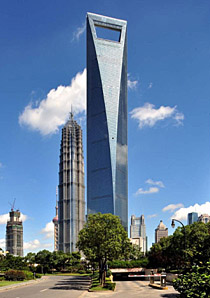
CNN: China retreats from building giant skyscrapers
 |
Of the ten completed buildings taller than 500 meters in the world, half are located in mainland China. Among them is the second tallest skyscraper in the world, the Shanghai Tower (632 meters), and the Ping An International Finance Center in Shenzhen (599 meters). In the last two years, the CITIC Tower in Beijing and the CTF Finance Center in Tianjin have joined them, making them the seventh and ninth tallest buildings in the world.
However, last year the number of new buildings measuring 200 meters or more in China fell by nearly 40 percent, according to data from the Council on Tall Buildings and Urban Habitat (CTBUH). In Beijing's central business district, a maximum height limit of 180 meters had already been established for new buildings.
The Wuhan Greenland Center skyscraper in Wuhan was originally meant to reach 636 meters, but after construction began, it was reduced to less than 500 meters, which required a fundamental change in the architectural design. Local media reported that the decision was due to air traffic safety.
The Suzhou Hungnam Center skyscraper in Suzhou, which was to reach a height of 729 meters, was also reduced to 499 meters, and the same fate befell planned high-rise buildings in Chengdu and Shenyang.
Fei Chen, a professor of architecture at the University of Liverpool in the UK, pointed out in this context the "reckless" construction of skyscrapers that some real estate agencies use for self-promotion, and local governments to enhance the visibility of their city. According to her, such towers are always extremely expensive and often unprofitable.
"The new guidelines are a response to the identity crisis of the 1980s when cities began looking abroad for construction models," Fei Chen told CNN. "In the 1990s, cities were encouraged to compete with others by building new landmarks and large public buildings," she added.
The current restrictions are being implemented from both design and economic perspectives. Beyond a certain height limit, the cost of each additional floor of a skyscraper increases exponentially. The skylines of Chinese cities are currently dotted with unfinished skyscrapers, as the slowdown in the country's economic growth has halted their construction.
According to CTBUH data, construction is currently on hold for about 70 Chinese buildings that were to exceed 200 meters. Three of them are expected to exceed 500 meters in height, including the Goldin Finance 117 skyscraper in Tianjin, whose foundation stone was laid more than ten years ago. The aforementioned Greenland Center in Wuhan also stands unfinished, with virtually no work being done on it since 2017.
Li Shi-qiao, a professor of Asian architecture at the University of Virginia, says the new measures are intended to serve as a model for future planning in cities. As an example, Li Shi-qiao points to the Shanghai financial district of Pudong, which has grown over the last two decades almost from scratch, and the newly constructed Xiongan city being built 100 kilometers southwest of Beijing. Unlike Pudong, the new satellite city features relatively low-rise development.
"If you take Pudong as a typical example of Chinese urbanization from 2000 to the present, and then look at Xiongan, whose development has not been dictated by real estate speculation or the desire to stand out with iconic buildings, then we are witnessing a remarkable change," noted Li. However, he added that the regulation to build skyscrapers with a maximum height of 500 meters is probably the least interesting part of the new government guidelines. Li also recalls the prohibition of "plagiarism and imitation." The Chinese Eiffel Tower and the London-inspired Thames Town near Shanghai are among the most extreme and ridiculed examples of how these imitations fared in architecture after 2000.
"There is already a general belief in Chinese architecture that imitations are unwelcome. However, China is huge, and every city is different. In cities on the eastern coast and other developed areas, there are usually higher-quality architects creating better, more interesting buildings. In some cities in the interior, however, we can still encounter buildings that copy other styles, and the result is not good," stated architecture professor Fei Chen.
The English translation is powered by AI tool. Switch to Czech to view the original text source.
0 comments
add comment
Related articles
0
11.05.2020 | The Chinese government has launched a campaign against imitation buildings from abroad
4
11.12.2008 | Changzhou "shortens" skyscrapers, wants to be on the UNESCO list
0
22.11.2008 | Shanghai World Financial Center is the most beautiful skyscraper this year
0
28.08.2008 | The highest Chinese building will open to the public on Saturday
0
19.11.2006 | China has shifted from copying products to copying entire cities












